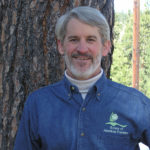
Is using wood for energy renewable? Is it sustainable? Does it destroy forests or make them better managed?
At Treesource, we are in the middle of a series of articles on wood energy. There are some strongly divergent perspectives on the carbon benefits or detriments of using wood for energy.
In my previous career, I was a forest ecologist and forester who developed and managed a program focused on using waste wood to heat schools, hospitals, colleges and more. So this is a debate with which I am familiar.
As with many debates, people often talk past one another because they have different assumptions about the fundamentals of the debate – sometimes out of lack of knowledge, sometimes with the purpose of misleading or diverting the discussion.
Here is a story that illustrates how carbon is stored in a tree and how soon that carbon is replaced after harvest. In this mythical story, Sarah Sustenance has a forest of 220 trees that she manages to provide wood products that help pay her bills and support her family.
She also wants to keep her forest healthy by minimizing wildfire and insect risks to the trees – and she likes to provide a wide variety of songbird habitat, as well as hunt wild turkeys for their meat and the feathers to make earrings, decorations on hats and tying flies for trout fishing.
To accomplish these diverse goals, Sarah reserves 20 of the trees from ever being harvested. They help shade the stream and provide big old trees for birds (like woodpeckers) that need them to carve out nests. When they die, these old trees provide snags used by birds and bats, and when they fall down they provide habitat for small animals, insects and fungi, and help protect and maintain the soil.
Sarah cuts down two trees every year and plants two seedlings to replace them. She cuts one that is 100 years old and one that is about 40 years old. The 100-year-old tree trunk is big enough to send to the sawmill and generates income for her family. The smaller top of the 100-year-old tree is too small for the sawmill, so she sells that to the local college to be chipped for heating and powering the campus.
The 40-year-old tree is too small or too crooked for the sawmill to use, so the whole tree is sent to the college for heat. The value of the small tree and top of the big one barely pays for itself to be hauled away and used.
So why does Sarah cut the small tree? Couldn’t she wait for it to get bigger and worth more? She thins the younger trees to give the remaining trees more room to grow and stay healthy. If the forest gets too thick, the trees become susceptible to insect attack, are at more risk from a wildfire or other problem, and reduce the foraging habitat for the birds she likes.
Does it take 40 years to replace the carbon in the tree that was thinned out and 100 years to replace the carbon from the top of the 100-year-old tree? No. It only takes one year.
You say, huh?? I don’t get it? It is because every year all 200 trees add an increment of growth in height and girth that in total are equal to the two trees removed. So the same amount of carbon is captured and stored every year in Sarah’s forest while also providing lumber that goes into a structure where the carbon remains stored. So there is a net removal of carbon from the atmosphere by her management of the forest.
In this country, we have close to 300 billion trees. If we managed 220 billion trees using Sarah’s method, we could sustainably harvest 2 billion trees a year – with the smaller, crooked and partially rotten ones used for wood energy or making paper, cardboard, adhesives and other everyday items, while the bigger sound trees are used for structures, furniture, flooring and more.
While this story is very simplified, the basic idea of regenerating, growing, harvesting and protecting some trees from harvest illustrates that we can use wood and forests renewably and sustainably for energy, whereas carbon from fossil fuels are not renewable or sustainable.
There are real and important nuances to this story that vary with the forest ecosystem, the type of energy produced, how it is used, and alternative uses of the wood. We will continue to analyze and debate these questions on Treesource in our upcoming stories.
However, we shouldn’t let those debates alter our understanding of the fundamental benefits of sustainable forest management (which includes reserved forests) as part of a low-fossil carbon long-term future.
It is as solid and uncomplicated at the macro-level, as Sarah illustrated for us, as it is nuanced at the micro-level. So let’s debate the nuance and accept and endorse the big picture.

Leave a Reply